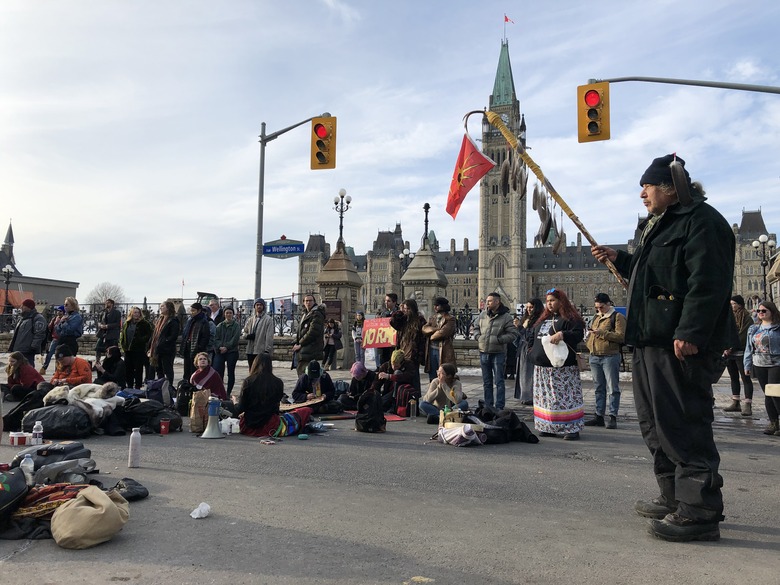Everything You Need To Know About The Recent Pipeline Protests
Some of Canada's indigenous chiefs have mounted a peaceful protest against a pipeline that would be built across their land.
Using everything from snowplows to trucks to wooden barrels to physically block important train tracks, the land defenders are trying to stop the construction of a pipeline that would be partially built across the land of the Wet'suwet'en Nation.
The protest didn't come out of nowhere. The hereditary chiefs of the land have been trying to negotiate a deal with developers since 2012 that would avoid a pipeline being built on the Wet'suwet'en land in British Columbia.
Eventually, a deal was reached, but it was with the elected officials of the Wet'suwet'en people, not the chiefs. Some of the officials gave a deal the thumbs up in part because it would give 620 million Canadian dollars to indigenous businesses contracted during the pipeline.
But the chiefs say that they're not concerned about money. They just want to keep their claim on the land where their ancestors have lived, and where they hope their future generations will be able to call home.
So, for about a year, they've been protesting the building, which has led to some arrests. Now, they've peacefully escalated the action by blocking some of Canada's biggest rail lines. The Canadian National Railway has had to shut down major routes, leading to millions of dollars of lost revenue for businesses that rely on trains shuttling their materials across the country. About 250,000 passengers have also had to cancel or change travel plans.
What is a Pipeline, Exactly? Is it Really So Bad?
What is a Pipeline, Exactly? Is it Really So Bad?
Pipeline can mean a few different things, but in this case, a pipeline is exactly what it sounds like: a line, or network, of pipes typically buried underground that will transport energy in the form of natural gas throughout Canada. The new one is supposed to be about 416 miles long. Across the globe, there are more than 2 million miles of pipelines that bring energy to markets around the world.
The U.S. and Canada weren't always so interested in building their own natural gas pipelines. But over the past 15 years, leaders have emphasized wanting to lessen North America's dependence on foreign countries for oil. Plus, demand has increased. In recent years, U.S. and Canada's pipeline construction has increased dramatically.
One of the most famous is the Keystone Pipeline. Four phases of this building are complete, but environmental activists protested against the completion of what's known as the Keystone XL. They are worried about the risk of spills along the pipeline, as well as the massive carbon footprint it would produce.
President Barack Obama blocked the completion of one part of the pipeline when he was in office, but the current administration gave building the thumbs up. But courts have issued appeals, and it's being held up in legal disputes.
Protesting Peacefully for Change
Protesting Peacefully for Change
While many environmental activists applaud the decision to be less dependent on oil, they don't believe the solution is to disrupt more natural environments and take over protected land to find or transport oil. And indigenous land defenders aren't necessarily opposed to growth and development, they just don't want it to happen on – especially in a move that echoes the tragic North American history of non-native people pushing indigenous people off their land.
Instead, environmental activists and land defenders hope that we can invest more in sustainable energy sources that leave behind less of a carbon footprint, don't carry as much risk of harming local environments and don't kick anyone out of their home.
Their demonstrations show that with peaceful action, maybe they can get leaders back to the bargaining table and work toward a solution that works better for everyone (planet included).
Cite This Article
MLA
Dragani, Rachelle. "Everything You Need To Know About The Recent Pipeline Protests" sciencing.com, https://www.sciencing.com/canadian-pipeline-protests-13724908/. 28 February 2020.
APA
Dragani, Rachelle. (2020, February 28). Everything You Need To Know About The Recent Pipeline Protests. sciencing.com. Retrieved from https://www.sciencing.com/canadian-pipeline-protests-13724908/
Chicago
Dragani, Rachelle. Everything You Need To Know About The Recent Pipeline Protests last modified March 24, 2022. https://www.sciencing.com/canadian-pipeline-protests-13724908/
